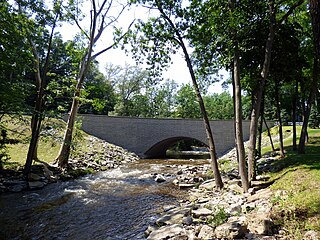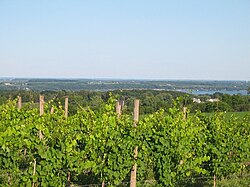History
The town is situated in the territory of the historic Seneca, who had an important village at Kanadaseaga ("Seneca Castle"), at the north end of Seneca Lake. This village was fortified during the Colonial Period as a defense against the French and was later used as a British stronghold during the American Revolution. It was destroyed by the Sullivan Expedition.
Post-revolution settlement began around 1788. The town was established from part of the Town of Seneca in 1872.
Seth Reed and his family settled here and owned an 18-mile tract of land in Ontario County between 1787 and 1795 before becoming the earliest settlers of Erie, Pennsylvania. [2] Colonel Reed had been involved in the Battle of Bunker Hill and the Canada campaign while serving in the Continental Army in the American Revolutionary War. His latter experiences in this region of New York may have attracted him to Ontario County and Geneva.
In 1806, the village called Geneva began to set itself apart from the town and was incorporated as a village in 1812. A new charter making Geneva a first class village was granted in 1871.
The loss of this territory to the City of Geneva made the town the smallest in the county.
Demographics
Historical population| Census | Pop. | Note | %± |
|---|
| 1880 | 7,412 | | — |
|---|
| 1890 | 1,320 | | −82.2% |
|---|
| 1900 | 1,091 | | −17.3% |
|---|
| 1910 | 1,086 | | −0.5% |
|---|
| 1920 | 1,251 | | 15.2% |
|---|
| 1930 | 1,327 | | 6.1% |
|---|
| 1940 | 1,436 | | 8.2% |
|---|
| 1950 | 1,771 | | 23.3% |
|---|
| 1960 | 2,603 | | 47.0% |
|---|
| 1970 | 2,781 | | 6.8% |
|---|
| 1980 | 3,077 | | 10.6% |
|---|
| 1990 | 2,967 | | −3.6% |
|---|
| 2000 | 3,289 | | 10.9% |
|---|
| 2010 | 3,291 | | 0.1% |
|---|
| 2020 | 3,478 | | 5.7% |
|---|
| 2021 (est.) | 3,493 | [1] | 0.4% |
|---|
|
As of the census of 2000, there were 3,289 people, 1,416 households, and 900 families residing in the town. The population density was 172.2 inhabitants per square mile (66.5/km2). There were 1,532 housing units at an average density of 31.0 persons/km2 (80.2 persons/sq mi). The racial makeup of the town was 93.65% White, 2.43% African American, 0.06% Native American, 1.73% Asian, 0.03% Pacific Islander, 0.52% from other races, and 1.58% from two or more races. 1.70% of the population were Hispanic or Latino of any race.
There were 1,416 households, out of which 24.2% had children under the age of 18 living with them, 54.9% were married couples living together, 6.6% had a woman whose husband does not live with her, and 36.4% were non-families. 31.4% of all households were made up of individuals, and 16.6% had someone living alone who was 65 years of age or older. The average household size was 2.32 and the average family size was 2.95.
In the town, the population was spread out, with 22.1% under the age of 18, 5.1% from 18 to 24, 23.5% from 25 to 44, 28.9% from 45 to 64, and 20.4% who were 65 years of age or older. The median age was 45 years. For every 100 females, there were 93.9 males. For every 100 females age 18 and over, there were 89.6 males.
The median income for a household in the town was $44,234, and the median income for a family was $58,350. Males had a median income of $39,186 versus $23,108 for females. The per capita income for the town was $22,990. 3.4% of the population and 1.8% of families were below the poverty line. Out of the total people living in poverty, 3.6% were under the age of 18 and 0.0% were 65 or older.
Springwater is a town in Livingston County, New York, United States. The population was 2,439 at the 2010 census. Springwater is in the southeast part of the county.
Seneca is a town in Ontario County, New York, United States. The population was 2,658 at the 2020 census. The town is named after a group of local natives.

Ridgeway is a town in Orleans County, New York, United States. The population was 6,886 at the 2000 census. The name of the town is derived from "Ridge Road," an important highway in the 19th century.
Hector is a town in the northeastern corner of Schuyler County, New York, United States. The population was 4,916 at the 2020 census. The town is named after Hector Ely, who at the time was the firstborn son of the town founders. Hector is west of Ithaca.
Fayette is a town in Seneca County, New York, United States. The population was 3,617 at the 2020 census. The town is in the north-central part of the county and is southeast of Geneva, New York.
Varick is a town in Seneca County, New York, United States. The population was 1,656 at the 2020 census. The town is named after Richard Varick, an officer in the American Revolution, mayor of New York City, and uncle of the first Town Supervisor, Anthony Dey.
Troupsburg is a town in Steuben County, New York, United States. The population was 1,016 at the 2020 census. The town is named after Robert Troup, an agent of the Pulteney Estate.

Benton is a town in Yates County, New York, United States. The population was 2,836 at the 2010 census. The town is named after an early resident, Levi Benton (1746-1820)

Jerusalem is a town in Yates County, New York. The population was 4,405 at the 2020 census. The town is named after the city of Jerusalem.

Milo is a town in Yates County, New York, United States. The population was 7,006 at the 2010 census. The town was named after Milo of Croton, a famous athlete from Ancient Greece.

Starkey is a town in Yates County, New York, United States. The population was 3,573 at the 2010 census. The town is in the southeastern section of the county and is south of Geneva.

Torrey is a town in Yates County, New York, United States. The population was 1,282 at the 2010 census. The name is taken from that of early county political leader Henry Torrey.

Geneva is a city in Ontario and Seneca counties in the U.S. state of New York. It is at the northern end of Seneca Lake; all land portions of the city are within Ontario County; the water portions are in Seneca County. The population was 13,261 at the 2010 census. The city is supposedly named after the city and canton of Geneva in Switzerland. The main settlement of the Seneca was spelled Zoneshio by early European settlers, and was described as being two miles north of Seneca Lake.
Livonia is a town in Livingston County, New York, United States. As of the 2010 census, the town population was 7,809. The town contains a village also named Livonia. The town is on the eastern border of the county.

Wilson is a town in Niagara County, New York, United States. The population was 5,993 at the 2010 census. The town was named after an early settler, Reuben Wilson, who built and dwelt in a log cabin on the shore of Lake Ontario at the site of what would become the Village of Wilson.
Canandaigua is a town in Ontario County, New York, United States. The population was 11,109 at the 2020 census.

Phelps is a town in Ontario County, New York, United States. The population was 6,637 at the 2020 census. The Town of Phelps contains a village called Phelps. Both are north of Geneva.
Ovid is a town in Seneca County, New York, United States. The population was 2,847 at the 2020 census. The town is named after the Roman poet Ovid, a name assigned by a clerk interested in the classics.

Waterloo is a town in Seneca County, New York, United States. The population was 7,378 at the 2020 census. The town and its major community are named after Waterloo, Belgium, where Napoleon was defeated.
Victor is an incorporated town in Ontario County, New York, United States. The population was 15,969 at the time of the 2020 census. The town is named after Claudius Victor Boughton, an American hero of the War of 1812.












